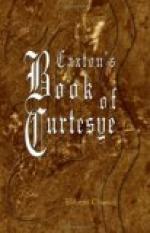The final d, f, t, of Hill’s MS., often have a tag to them. As they sometimes occur in places where I judge they must mean nothing, I have neglected them all. Every final ll has a line through it, which may mean e. Nearly every final n and m has a curly tail or line over it. This is printed e or [=n], though no doubt the tail and line have often no value at all. The curls to the rs are printed e, because ther with the curly r, in l. 521, Hill, rimes to where of l. 519.
At the end of Caxton’s final d and g is occasionally a crook-backed line, something between the line of beauty and the ordinary knocker. This no doubt represents the final e of MSS., and is so printed, as Mr Childs has not the knocker in the fount of type that he uses for the Society’s work. Caxton’s [=n] stands for un in the _-aunce_, _-aunte_, of words from the French. No stops or inverted commas have been put to Caxton’s text here, but the stanzas and lines have been numbered, and side-notes added.
“The Book of Curtesye,” says Mr Bradshaw, “is known from three early editions. The first, without any imprint, but printed at Westminster by Caxton ab. 1477-78,[1] the only known copy of which is here reproduced. The second (with the colophon ’Here endeth a lytyll treatyse called the booke of Curtesye or lytyll John. Emprynted atte Westmoster’) is only known from a printer’s proof of two pages[2] preserved among the Douce fragments in the Bodleian. It must have been printed by Wynkin de Worde in Caxton’s house ab. 1492. In the third edition it was reprinted at the end of the Stans puer ad Mensam by Wynkin de Worde ab. 1501-1510. The Cambridge copy is the only one known to remain of this edition.”
[Footnote 1: In his type No. 2, Blades, ii. 63.]
[Footnote 2: In Caxton’s type No. 5, Blades, ii. 235 (not 253 as in Index).]
I have no more to say: but, readers, remember this coming New Year to do more than last for what Dr Stratmann calls “the dear Old English.” Think of Chaucer when his glad spring comes, and every day besides; forget not Langland or any of our early men:
&nb
sp; reporte
& revyue the lawde
of the_m_ th_a_t were
famovs i_n_[1] owr_e_ langage,
these faders dere,
whos sowles i_n_
blis, god et_er_nall avaunce,
that lysten
so[2] owr_e_ langage to enhavnce!
(Hill, l. 430-4.)
[Footnote 1: Founders of, Oriel MS.]
[Footnote 2: some, Hill; so, Oriel.]
3, St George’s Square, N.W.
15 Dec., 1867._
The Book of Curtesye.
[The Book of Curtesy.]
[From the Oriel MS. lxxix.]
[1]




